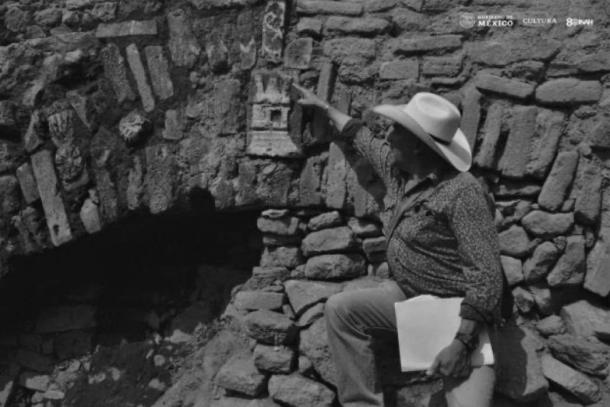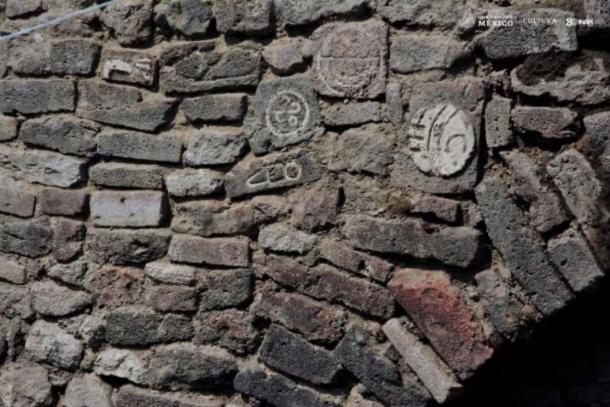In 2019, archaeologists in Ecatepec, México state, found a centuries old tunnel with symbolic imagery. The find was so intriguing that the National Institute of Anthropology and History ( INAH) had planned to make an exhibit of the strange tunnel. But now, just two years later, those plans have fallen through, and the archaeologists are going to have to cover the finds in dirt again.
The tunnel in Ecatepec is part of a 17th-century colonial dike system called the Albarradón de Ecatepec and archaeologists from the INAH found 11 pre-Hispanic symbols detailed on the side walls. According to an article in Mexico News Daily , an INAH spokesperson said in a statement that among the images discovered on the walls of the 8.4-meter-long (27.6 ft.) tunnel were petroglyphs, stucco relief panels, a war shield, a bird of prey’s head, and a “paper ornament.” Furthermore, a teocalli, or temple, was found etched into the central stone of the arch entrance dedicated to the rain god Tláloc , according to the INAH archaeologists.

A teocalli, or temple, was found etched into the central stone of the arch entrance dedicated to the rain god Tláloc. ( Edith Camacho, INAH )
Aztec/Spanish Water Wars
The meaning of some of the carved and embossed images is still unknown and Raúl García, coordinator of a project to preserve the archaeological dike system, said in 2019 that the images might have been executed by the indigenous people who lived in the pre-Hispanic towns of Ecatepec and Chiconautla. Supporting this hypothesis, archaeologists know that indigenous residents from both of these towns had worked on the construction of the dike.
The tunnel is part of a 2.5-mile-long (4 km) network of dikes upon which construction began in the 15th century by Moctezuma I to control the flow of water into what is today Mexico City, which stood on an island at the center of a complex system of inland lakes. Moctezuma I was the second Aztec emperor and fifth king of Tenochtitlan who ruled between 1440 to 1453 AD and is credited by historians as having consolidated the Aztec Empire and set in motion a major social expansion program which thrived with 11,000,000 people until the arrival of the Spanish.

The tunnel is part of a 2.5-mile-long network of dikes. ( Edith Camacho, INAH )
The dike was eventually destroyed by Spanish conquistador Hernán Cortés and later reconstructed to control flooding. Dr. García explained that the tunnel in which the images were discovered is in a section of the dike known as the Patio de Diligencias , or ‘courtyard of diligence’.
Heirs of Aztec Cultural Heritage
Among the other less symbolic artifacts found within the ancient tunnel were four iron nails, two wooden beams, and a pile of organic material that is thought to have perhaps been part of a gate leading to the 17th-century dike. The glyphs and stucco panels have been damaged by hundreds of years of rain and changing environmental conditions.
Ecatepec is Mexico’s second most populous municipality located just north of Mexico City and is part of the Valley of Mexico metropolitan area. The Albarradón de Ecatepec was declared a historical monument in 2001 and will now be incorporated into a public park. It is hoped the opening of this new park will allow people to enjoy the “cultural heritage to which they are heirs.” However, archaeologists have had to give up on their plans to open the tunnel to the public.

The tunnel where the images were discovered. ( Edith Camacho, INAH )
Reburying the Unusual Tunnel
According to ABC News , the decision to rebury the site is a reaction to the coronavirus pandemic, which has forced the government to shift focus and funds to health care. The INAH released a statement saying “it must be considered that the world-wide COVID-19 health emergency forced all levels of government to place priority on assigning money to health care for the population. For that reason, the archaeological project had to be postponed.”
But archaeologists still hope that someday there will be enough money to build a display for the unusual tunnel which combines colonial and pre-Hispanic features.
Collapse of a Thriving Empire
When the Spanish conquistadors arrived, led by Hernán Cortés , they initially befriended the leader of the Aztecs, Moctezuma II, and valuable gifts were exchanged. But on June 30, 1520 AD, in what became known as the Noche Triste, Cortés besieged the Aztec capital of Tenochtitlan on the western shore of Lake Texcoco, but was repelled by the Aztec warriors.
10 months later, in 1521 AD, Cortés returned with allies and again laid siege to the Aztec capital city, and lacking resources and having been ravaged by disease, the Aztecs, now led by Cuauhtemoc, finally collapsed on August 13, 1521 AD. Tenochtitlan was destroyed and from the ashes rose the new capital of the colony of ‘New Spain’ and the ancient lineage of Mesoamerican people with heritage and traditions originating with Olmec cultures came to a sharp, bloody, and quick end.
Top Image: A war shield and a bird of prey’s head are two of the Pre-Hispanic symbols discovered in the Mexican tunnel that will be reburied. Source: Edith Camacho, INAH
By Ashley Cowie
Updated July 24, 2021.
 RSS Feed
RSS Feed















 July 25th, 2021
July 25th, 2021  Awake Goy
Awake Goy  Posted in
Posted in  Tags:
Tags: 













